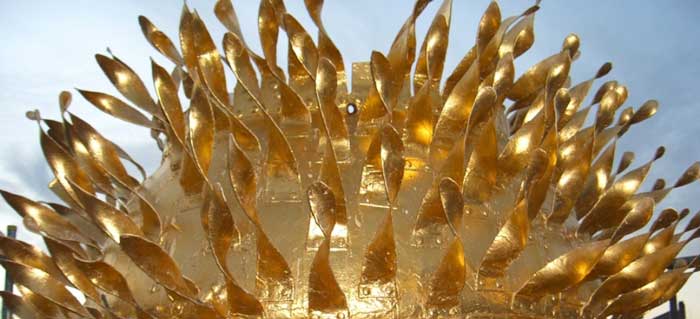
Standing gracefully at the intersection of Monument Street and Fish Street Hill in the City of London, the Monument to the Great Fire of London was built between 1671 and 1677 to commemorate the devastating incident of the fire and to celebrate the rebuilding of the City, which rose from the ashes. The 202 feet high fluted Doric column crowned with a glittering gilded urn with emerging flames, was designed by Sir Christopher Wren and Dr Robert Hooke.
The Great Fire began on Sunday 2nd September 1666, in a bakery on Pudding Lane, owned by the King’s baker, Thomas Farriner. Perhaps, the ovens of the bakery were not properly extinguished and the existing heat somehow created sparks, which set alight the wooden house of the owner. During those days, most of the buildings of the city of London were made of wood, which is highly inflammable. Added to it, the dry summer helped the flames to spread quickly throughout the city. The raging fire was finally extinguished after three days, on Wednesday, the 5th September, after consuming one third of the city buildings, including 85 churches and damaging hundreds of streets. Though there was little loss of life, the fire enforced all activities of the city to a halt and 130,000 people were made homeless.

Subsequent to the fire, Parliament enforced guidelines for the rebuilding of the city, which include construction of wider roads, construction of buildings with brick and stone rather than timber and construction of churches. It was also decided that, in remembrance of the devastation, a column of either brass or stone should be constructed on Fish Street Hill, on or near the site of the bakery, where the fire initiated. The task of rebuilding London was entrusted to a committee of six, including Sir Christopher Wren, Surveyor General to King Charles II and the architect of St. Paul’s Cathedral. Designed by Christopher Wren and architect Robert Hooke, the construction of the monument commenced in 1671.However, it took long six years to complete the construction of the column, due to the non availability of enough Portland stone of the required dimensions. Nevertheless, it was completed and opened in 1677, though it took another two years before the inscription was set in place.


Originally, Wren intended to install a statue of a winged phoenix rising from the ashes, later he opted for a 15 ft statue either of Charles II, or a sword-wielding female representing a triumphant London, at an estimated cost of about £1,050.However, Charles himself disliked and rejected the idea of his statue atop the monument and instead preferred a simple copper-gilded ball with flames sprouting from the top. Ultimately, the design of a flaming gilt-bronze urn, as suggested by the architect Hooke was finalized.



The Monument to the Great Fire of London is equipped with a spiral stone staircase of 311 steps leading to a viewing platform. Later, a mesh cage was added to the platform in the mid-19th century as a safety measure, to prevent people jumping off. History says, between 1788 and 1842, six people had committed suicide from the point.
The 202 feet high Monument to the Great Fire of London is just 202 feet away from the spot in Pudding Lane, where the great fire initiated on the 2nd of September 1666. The Golden Boy of Pye Corner, another little monument, marks the point where the fire was extinguished, which was constructed between 1671 and 1677 on the site of St. Margaret’s, the first church devoured by the fire.


Three sides of the base of the monument contain inscriptions in Latin. The south side describes the actions taken by King Charles II, after the incident of the disastrous fire, while the north side describes the history of the fire, relating about its source, its effect, and how it was eventually extinguished. The text on the east side originally falsely blamed Roman Catholics for the fire, which was chiseled out in 1830. The base of the west side is decorated with a detailed sculpture, by Caius Gabriel Cibberith, illustrating King Charles II, and his brother, James, the Duke of York surrounded by Liberty, Architecture, and Science, perhaps giving directions for its restoration.


During WWII, the Monument was closed to visitors for obvious reasons. In those days of war, London was bombed extensively, when 30.000 Londoners were killed, over 50.000 got seriously injured and hundreds of thousands of people were made homeless. Strangely enough, though tens of thousands of buildings were destroyed by severe bombing, Pudding Lane, where the 1666 Fire began, escaped serious damage and except superficial damage from bomb fragments, the Monument to the Great Fire of London miraculously withstood the onslaught. After the end of the Great War, the Monument was reopened the public on 13th August 1945.

From time to time, the Monument has undergone frequent repair and redecoration. The column was completely renovated in May 1834, along with the re-gilding of the gilded urn at the top. Since then, the urn is re-gilded periodically. In 1954, the column was steam-cleaned and the bomb scars were removed.